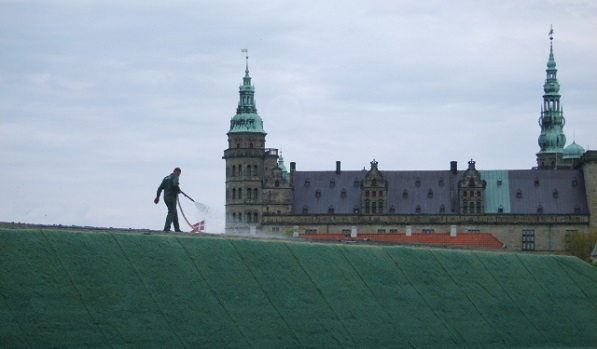- Species & varieties
- Mixtures and brands
- Turf for tough conditions
- Turf by use and activity
- Turf management
- Brown patch resistant turf
- 4turf - turf tetraploid perennial ryegrass
- 4salt - enhanced salt tolerance
- ProNitro - Ready to grow
- Accelerator seed coating
- DLF Select - high purity seeds
- Microclover - green and lush
- DLF Academy
- Turf references
- Roots
Turf for irregular terrain
Hydroseeding is the easiest – and sometimes the only – way to establish grass cover on steep slopes, the edges of watercourses, and other locations where access is difficult. It's also a very useful technique for landscaping and environmental applications – for establishing grass on rubbish tips, controlling dust on coal tips, and combatting soil erosion.
Hydroseeding for any location
If you're unfamiliar with hydroseeding, it's a sowing method that involves spraying a slurry containing your chosen seed mixture, fertiliser, and a cellulose material that helps bind the seed to the ground.
Hydroseeding is so safe, efficient, and practical, it's often used as an alternative to normal seeding on areas larger than 1.000 m². For example, if the prepared surface is so delicate it can't be driven on, hydroseeding lets you sow seed and add fertiliser in a single, low-impact operation. That's why hydroseeding is as likely to be used on golf greens as it is on grass verges.

Sow any seed you like
You can sow any type of seed with hydroseeding – anything from the smallest grass seeds through wild herbs to seeds of woody plants. You choose the seed that's right for the location and the project.
Since hydroseeding is not dependent on the weather, you can continue to sow throughout the growing season. You judge the time for hydroseeding by the level of establishment of earlier seedings.
No special seedbed required
Hydroseeding works on flat and irregular terrain, so there's no need to prepare the ground first. You don't even have to remove stones or rocks. The only reason you'd prepare the ground is when you want to use the finished grass for a specific purpose.
Species for landscaping and hydroseeding
Growing conditions vary widely across terrain suitable for hydroseeding. Here are our suggestions for various applications:
- Low-maintenance: Red fescues such as slender creeping red fescue, strong creeping red fescue and chewings fescue are a feature of many landscape applications because they require minimal maintenance.
- Soil fixing and stabilisation: To stabilise soil quickly and prevent erosion, include ryegrass (lolium perenne) in your seed mixtures. Perennial ryegrass, with its deep root penetration, is excellent too. Annual (westerwoldicum) or Italian ryegrass also works well, with the added advantage that it soon disappears.
In more extreme conditions on steeper slopes, it helps to mix in 10% Italian ryegrass (lolium multiflorum) for optimum germination and establishment. Strong creeping red fescue (festuca rubra rubra), with its long underground rhizomes, is good for soil stabilisation. And it regenerates well after summer stress.
- South-facing slopes: On warm soils that dry out fast, red fescue (Festuca rubra) and hard fescue (Festuca trachyphylla) fare best. They also do well in locations that might be cut only once a year.
- Road verges: Salt-tolerant slender creeping red fescue (Festuca trichophylla) is an excellent choice for roads subject to winter salting.
- Hot environments: In the heat of southern Europe, tall fescue (Festuca arundinacea) grows well.
